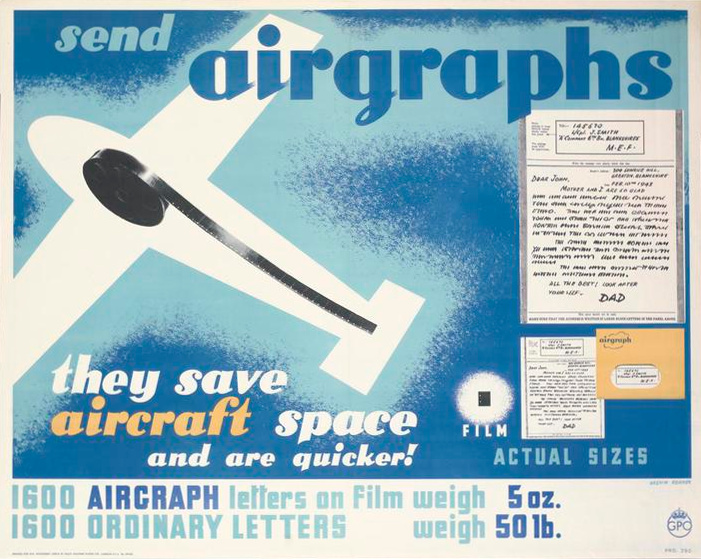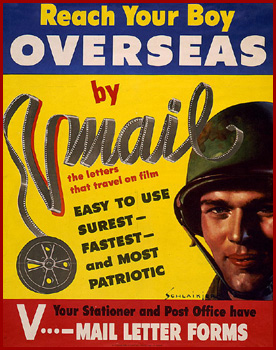RARE Stock Certificate from Airgraphs, Ltd.issued in 1940. This historic document has an ornate border around it with the company's name on top center. This item is hand signed by the company's officers and is over 76 years old. This certificate was issued to Eastman Kodak Company. Tape was used to attach the certificate back to the original ledger stub. The shares of stock were issued in accordance with an agreement dated in 1938 between Eastman Kodak Company, Pan American Airways, and Imperial Airways, Ltd. 
Old Airgraphs' V-mail advertisement shown for illustrative purposes 
Shown for illustrative purposes The airgraph was invented in the 1930s by the Eastman Kodak Company in conjunction with Imperial Airways (now British Airways) and Pan-American Airways as a means of reducing the weight and bulk of mail carried by air. The airgraph forms, upon which the letter was written, were photographed and then sent as negatives on rolls of microfilm. A General Post Office (GPO) poster of the time claimed that 1,600 letters on film weighed just 5oz, while 1,600 ordinary letters weighed 50 lbs. At their destination the negatives were printed on photographic paper and delivered as airgraph letters through the normal Royal Engineers (Postal Section) - also known as the Army Postal Services (APS) - systems. V-mail correspondence was on small letter sheets, 17.8 cm by 23.2 cm (7 by 9 1/8 in.), that would go through mail censors before being photographed and transported as thumbnail-sized image in negative microfilm. Upon arrival to their destination, the negatives would be blown up to 60% of their original size 10.7 cm by 13.2 cm (4 ¼ in. by 5 3/16 in.) and printed. Support of women as sorters helped facilitate the delivery of mail on the homefront. Another lesser known role played by women supporting the troops during the war. According to the National Postal Museum, "V-mail ensured that thousands of tons of shipping space could be reserved for war materials. The 37 mail bags required to carry 150,000 one-page letters could be replaced by a single mail sack. The weight of that same amount of mail was reduced dramatically from 2,575 pounds to a mere 45." This saved considerable weight and bulk in a time in which both were hard to manage in a combat zone. During World War II, there were many problems associated to sending mail to and from troops far away from home. The amount of mail was huge, and mail transport from one continent to another was difficult. The allied countries developed a special postal service to reduce the mail volume. The English version of these sheets is called Airgraphs, while V-mail was the US system. Illustrated sheets were handed out to the troops and their folks at home, where the sender could fill in name and address to the receiver. The forms were sent to dedicated V-mail stations, or photo stations, where they were photographed (16 mm film), and the film was sent to a photo station on the same continent as the addressee. There the pictures were processed and enlarged, and were mailed to the addresse by ordinary mail. The original forms were 21 cm wide by height 28 cm, while the processed forms are 10.5 by 13 cm. On the same side as the written or drawn message was space for name and address to sender and receiver. On the other side of the form were printed instructions for use, and space for address to the V-mail station. This side was not photographed. Personnel in the armed forces were allowed to send the forms postage free to the photo station, while civilians had to stamp their V-mail forms. The processed V-mails were sent postage free from the photo station to the receiver. The sheet was folded after processing/enlarging, and placed in a special purpose window envelope, so that the receiver's name and address was shown through the window. All processed V-mails have therefore a horizontal bend slightly above the centre. The envelopes are not very exciting for thematic collectors, but on the V-mails and Airgraphs one can find many fine illustrations. The illustrations are considered to be fully postal, and can be used in a F.I.P. competitive thematic exhibit. Most common was the use of sheets with pre-printed text and illustrations, but there was also a possibility for writing and illustrating the sheet yourself. The sheets often show religious illustrations, such as Christmas or Easter greetings; caricatures or war scenes. As the theatres of service during the second war reached further and further from our home shores, the British Post Office was confronted with the formidable task of maintaining the lines of communication between the serving Forces and their loved ones at home at the lowest possible cost. The valiant men and women in general service were allowed to send letter upto a weight of two ounces, by surface mail free of charge. When Benito Mussolini declared war on Britain and France in June, 1940, the situation was further aggravated by his closing the Suez Canal and the Mediterranean to Allied seaborne traffic. The consequence of this was that mail to and from British soldiers serving in the Middle and Far East had to travel home by way of the Cape of Good Hope - a detour of 12,000 miles. This meant that a letter from Cairo or Bombay could be in transit for anything from three to six months. In an effort to overcome this delay, the possibility of using air transport was considered but, during these early years of the war, few transport aircraft were available and those that were had little space available for carrying mail. To find a solution to this problem, a study was made into the feasibility of using micro-photography. The result was the Post Office innovation, the Airgraph Service, which was inaugurated in August, 1941, by Her Majesty the Queen (now Her Majesty the Queen Mother) who sent the first airgraph letter to Egypt addressed to the Commander-in-Chief, General Auchinleck. One feature of the service was that all airgraph letters arrived at their destination. Because each message was numbered and photographed, it was possible for any mail lost in transit to be quickly reproduced from the original. An example of how quickly this could be accomplished can be seen from the case of the flying boat 'CLARE' which was lost in September, 1941, whilst carrying mails from India, East Africa and South Africa. As soon as the loss had been confirmed the countries of origin were speedily contacted by telegraph and duplicates of the lost films were received in London on the 15th October, then processed and delivered to the addressees within three days. The figure of ten million airgraphs despatched from the United Kingdom to the Middle East was reached at the end of May, 1942. The total weight of film involved was less than one ton (1016 kg.). The equivilent weight of air mail letters would of been in excess of one hundred tons. By October 1st, 1942, when about one million airgraphs were being sent in each direction, in and out of the country, each week, the total number of airgraphs handled reached forty-five millions. By the time the service was discontinued in July, 1945, 330,000,000 messages had been handled. Airgraph forms were available from local post offices upon request. With the form was given a verbal warning that it must not be folded or creased in any way and that the writing should be clear and distinct. The message, anything upto 230 words, was then written on the form and either handed back over the counter or, as was the case in some rural areas where people were concerned with the aspect of privacy, it could be forwarded direct to the London office which was situated in King Edward Building (subsequently KEB), near St. Paul's Cathedral. On arrival at KEB the forms were individually hand-stamped with consecutive numbers by Post Office women workers who worked at an amazing speed. (In 1944 it was stated that 'no machine can match the combination of a swift right arm and a deft feminine left hand thumb and finger.') The forms were then sorted by men and women of the Army Postal Service for the various arms of the Services and the theatres of war. Having been so segregated the forms were then photographed in miniature by a girl sitting at what looked like a flat-topped metal desk. In the top of the desk was a slit, just wide enough to accept a single form. As each form was inserted into the slit, it automatically operated a light switch and was illuminated for a fraction of a second, long enough to be photographed by a 16 mm camera situated below the desk. The resulting film, 100 feet long and 16 millimetres wide, contained a continuous succession of 1,700 airgraph photographs and, with the metal container into which it was coiled, weighed 5½ ounces (154g.). These messages, if sent by ordinary letter post would have weighed 50lbs (22.5kg.). The film of reduced airgraphs was taken by plane to its destination where the process was reversed and the film projected onto a strip of moving sensitized paper resulting in a series of positive prints approximately one quarter the size of the original. The strip was then cut and each airgraph print inserted into an envelope by hand or machine ready for delivery to the addressee. History from Wikipedia, Encyberpedia and OldCompany.com (old stock certificate research service)

Old Airgraphs' V-mail advertisement shown for illustrative purposes

Shown for illustrative purposes








